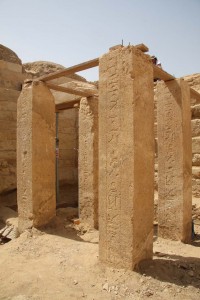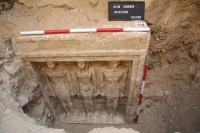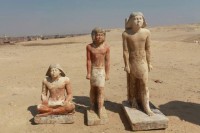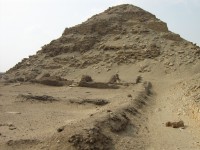 Archaeologists from the Czech Institute of Egyptology have unearthed the tomb of a princess of the 5th Dynasty (2494 to 2345 B.C.) in the Abu Sir necropolis 20 miles south of Cairo. Only the antechamber has been discovered so far, but that was enough to identify it as the burial of Princess Shert Nebti thanks to the four limestone pillars inscribed with hieroglyphics including her name and titles.
Archaeologists from the Czech Institute of Egyptology have unearthed the tomb of a princess of the 5th Dynasty (2494 to 2345 B.C.) in the Abu Sir necropolis 20 miles south of Cairo. Only the antechamber has been discovered so far, but that was enough to identify it as the burial of Princess Shert Nebti thanks to the four limestone pillars inscribed with hieroglyphics including her name and titles.
One of the titles describes her as “the daughter of the king Men Salbo and his lover venerated before God the all-powerful.” The list of known pharaohs of the 5th Dynasty is small and “Men Salbo” is not among them, although it could be an alternate name. By 2000 B.C. pharaohs regularly went by five names: the Horus name, the Nebti name, the Gold Horus name, the Throne name and the Birth name. It’s rare even for pharaohs of later, better documented dynasties to have all five names included in one inscription, so when a new name crops up it doesn’t necessarily mean a new pharaoh has been added to the timeline.
 Princess Shert Nebti’s tomb is significant not just in and of itself, but also because it appears to have been a hub connected to other tombs in the necropolis. An opening in the southeast of the antechamber was excavated to reveal a corridor leading to four tombs. Four limestone sarcophagi were found in the hallway, each containing several figurines, among them statuettes of a man, another man with his son, and two men with a woman.
Princess Shert Nebti’s tomb is significant not just in and of itself, but also because it appears to have been a hub connected to other tombs in the necropolis. An opening in the southeast of the antechamber was excavated to reveal a corridor leading to four tombs. Four limestone sarcophagi were found in the hallway, each containing several figurines, among them statuettes of a man, another man with his son, and two men with a woman.
Of the four tombs the corridor leads to, two of them are new discoveries, while the other two, belonging not to royal family members but to court officers described in inscriptions as a “grand upholder of the law” and an “inspector of the servants of the palace,” had been found in earlier excavations. They date to the reign of 5th Dynasty Pharaoh Djedkare Isesi (2414–2375 B.C.).
 The two newly discovered tombs are currently being excavated. In one of them, a false door and three limestone statues have already been unearthed. In inscriptions, the tomb’s occupant, Nefer, is described as the “supervisor of scribes,” and indeed the statues found are depictions of scribes. This would have been a high ranking official with an administrative role at the pharaonic court. For instance, Ptahhotep, a scribe from the reign of Pharaoh Djedkare Isesi, was that pharaoh’s prime minister and is the traditional author of a book of maxims that is among the earliest philosophical works surviving. We have no way of knowing if the maxims were actually written by the historical Ptahhotep, but they are attributed to him in the oldest extant manuscripts from the Middle Kingdom and his authorship, even if more legendary than factual, underscores the importance, even fame, of scribes in pharaonic Egypt.
The two newly discovered tombs are currently being excavated. In one of them, a false door and three limestone statues have already been unearthed. In inscriptions, the tomb’s occupant, Nefer, is described as the “supervisor of scribes,” and indeed the statues found are depictions of scribes. This would have been a high ranking official with an administrative role at the pharaonic court. For instance, Ptahhotep, a scribe from the reign of Pharaoh Djedkare Isesi, was that pharaoh’s prime minister and is the traditional author of a book of maxims that is among the earliest philosophical works surviving. We have no way of knowing if the maxims were actually written by the historical Ptahhotep, but they are attributed to him in the oldest extant manuscripts from the Middle Kingdom and his authorship, even if more legendary than factual, underscores the importance, even fame, of scribes in pharaonic Egypt.
 According to Egyptian Antiquities Minister Mohamed Ibrahim, the discovery of Princess Shert Nebti’s tomb and the links it establishes to other tombs in the necropolis “marks the beginning of a new era in the history of the sepulchres at Abu Sir and Saqqara.” Abu Sir and Saqqara were both used as burial grounds by the pharaohs and nobles of the 5th Dynasty after Giza ran out of space thanks to the huge monuments of the 4th Dynasty pharaohs, namely the Great Pyramids and the Great Sphinx. There are 14 pyramids at Abu Sir, all of them step pyramids, all of them relatively small (the largest, the pyramid of Neferirkare Kakai, was 240 feet high when first built, contrasted with the Great Pyramid of Khufu’s original height of 481 feet) and all made out of cheaper local stone instead of the rich limestone used in the Great Pyramid.
According to Egyptian Antiquities Minister Mohamed Ibrahim, the discovery of Princess Shert Nebti’s tomb and the links it establishes to other tombs in the necropolis “marks the beginning of a new era in the history of the sepulchres at Abu Sir and Saqqara.” Abu Sir and Saqqara were both used as burial grounds by the pharaohs and nobles of the 5th Dynasty after Giza ran out of space thanks to the huge monuments of the 4th Dynasty pharaohs, namely the Great Pyramids and the Great Sphinx. There are 14 pyramids at Abu Sir, all of them step pyramids, all of them relatively small (the largest, the pyramid of Neferirkare Kakai, was 240 feet high when first built, contrasted with the Great Pyramid of Khufu’s original height of 481 feet) and all made out of cheaper local stone instead of the rich limestone used in the Great Pyramid.
The Czech Institute of Egyptology, part of the Faculty of Arts at Charles University in Prague, has been excavating at Abu Sir each digging season since 1976. The team’s website doesn’t appear to have been updated for a while so there’s no news on the princess’ tomb, but it does have an excellent overview of the history of Abu Sir, of the royal pyramid complexes, and of the necropolis of non-royal officials.
Edit: The Luxor Times Magazine blog has more details about the find and additional pictures.
I’m interested in seeing all these statuettes!
Check the link I just edited in! There are several more pictures there. 🙂
I am so happy I stumbled upon your site, and plan to read the whole thing cover to cover!
Thank you so much for al your hard work. I greatly appreciate it.
-Tom
Thank you for reading and for saying such nice things. :thanks:
:O Yay!
FANTASTIC THAT IN 2012 WE CAN STILL EXCAVATE NEW TOMBS AND LEARN MORE.
BENJAMIN MARCUS RAUCHER
One minor quibble: Saqqara was in use as a royal cemetery for a long time before Khufu started building the Great Pyramid at Giza. Gize did not “run out of room”; rather, his great-grandsons moved their tombs back to Saqqara, the traditional resting place for Pharaohs at that time. Indeed, Saqqara is the site of the oldest stone building in the world, the Step Pyramid of Djoser, which was built a generation or so before the Great Pyramid was built.
I’ve heard it said many times that the history of ancient Egypt for the most part still lies undetected,owned by no one but the Sahara.Will all the truth eventually come out?I really doubt it and feel that it should be so.Her soul,her spirit,the very basis of the ideas represented by the ankh is her own.Greed and the always invasive signs($) that drive most reasoning behind the searching and digging is a crime.And I don’t include the archeaologists with a historical agenda.Garry in Kentucky
Buenas ,, muy buen reportaje arqueológico me gustaría saber un poco mas acerca de este teme en general y también ver fotos acerca de este descubrimiento,, sin mas y agradeciendo atte